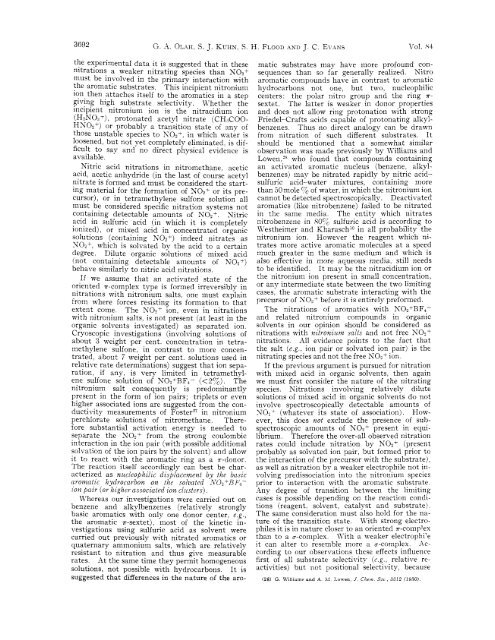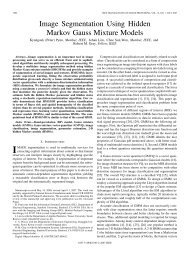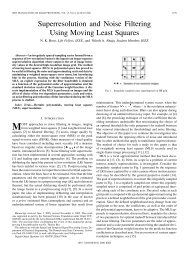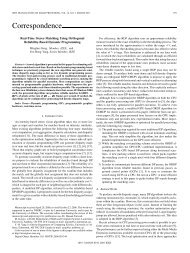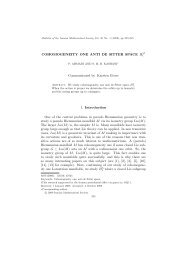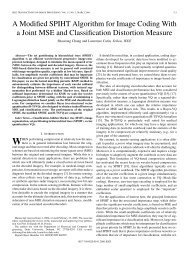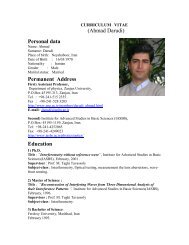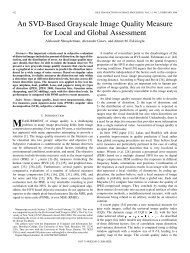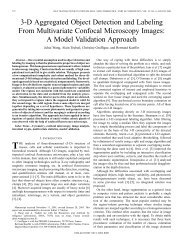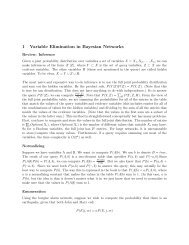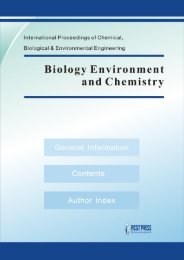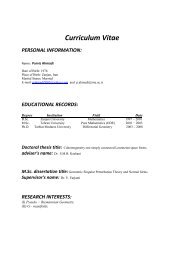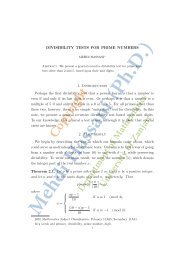Aromatic Substitution. XIII.la Comparison of Nitric Acid and Mixed ...
Aromatic Substitution. XIII.la Comparison of Nitric Acid and Mixed ...
Aromatic Substitution. XIII.la Comparison of Nitric Acid and Mixed ...
You also want an ePaper? Increase the reach of your titles
YUMPU automatically turns print PDFs into web optimized ePapers that Google loves.
3692 G. -4, OLAH, S. J. KUEIN. S. H. FLOOD AND J. C. EVANS<br />
the experimental data it is suggested that in these<br />
nitrations a weaker nitrating species than NO2+<br />
must be involved in the primary interaction with<br />
the aromatic substrates. This incipient nitronium<br />
ion then attaches itself to the aromatics in a step<br />
giving high substrate selectivity. U'hether the<br />
incipient nitronium ion is the nitracidium ion<br />
(HaNO:jT), protonated acetyl nitrate (CH:,COO-<br />
HNO%+) or probably a transition state <strong>of</strong> any <strong>of</strong><br />
those unstable species to KO%+, in which water is<br />
loosened, but not yet completely eliminated, is difficult<br />
to say <strong>and</strong> no direct physical evidence is<br />
avai<strong>la</strong>ble.<br />
<strong>Nitric</strong> acid nitrations in nitromethane, acetic<br />
acid, acetic anhydride (in the <strong>la</strong>st <strong>of</strong> course acetyl<br />
nitrate is formed <strong>and</strong> must be considered the starting<br />
material for the formation <strong>of</strong> XO2+ or its precursor),<br />
or in tetramethylene sulfone solution all<br />
must be considered specific nitration systems not<br />
containing detectable amounts <strong>of</strong> NO%+. <strong>Nitric</strong><br />
acid in sulfuric acid (in which it is completely<br />
ionized), or mixed acid in concentrated organic<br />
solutions (containing Ihu'O2+) indeed nitrates as<br />
NO?+, which is solvated by the acid to a certain<br />
degree. Dilute organic solutions <strong>of</strong> mixed acid<br />
(not containing detectable amounts <strong>of</strong> NO2+)<br />
behave simi<strong>la</strong>rly to nitric acid nitrations.<br />
If we assume that an activated state <strong>of</strong> the<br />
oriented n-complex type is formed irreversibly in<br />
nitrations with nitronium salts, one must exp<strong>la</strong>in<br />
from where forces resisting its formation to that<br />
extent come. The NOr+ ion, even in nitrations<br />
with nitronium salts, is not present (at least in the<br />
organic solvents investigated) as separated ion.<br />
Cryoscopic investigations (involving solutions <strong>of</strong><br />
about 3 weight per cent. concentration in tetramethylene<br />
sulfone, in contrast to more concentrated,<br />
about 7 weight per cent. solutions used in<br />
re<strong>la</strong>tive rate determinations) suggest that ion separation,<br />
if any. is very limited in tetramethylene<br />
sulfone solution <strong>of</strong> N02+BF4- (


